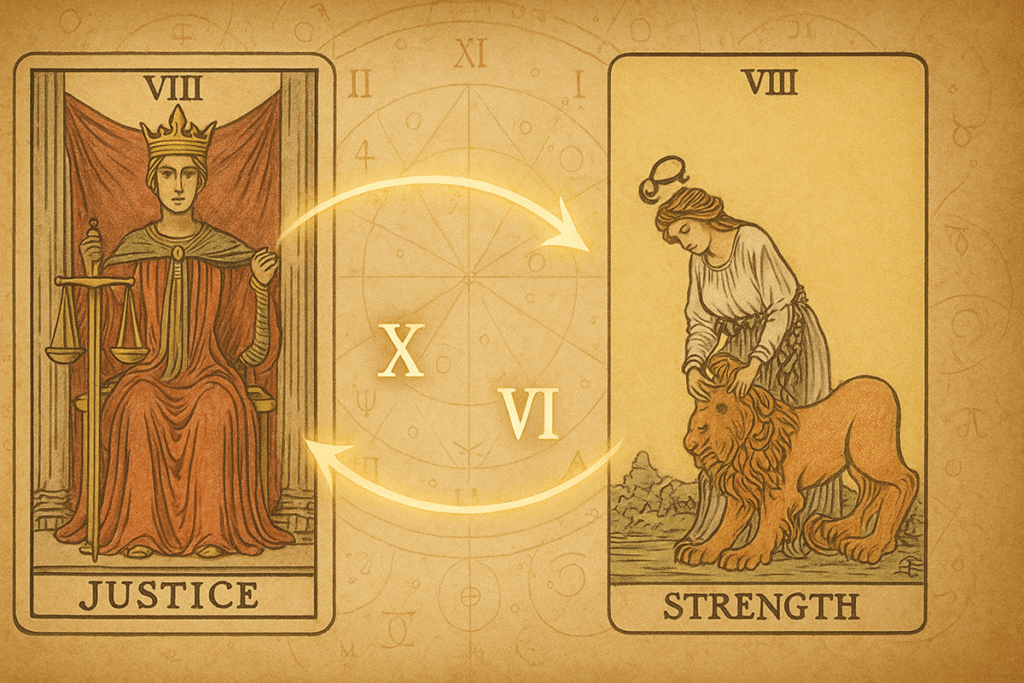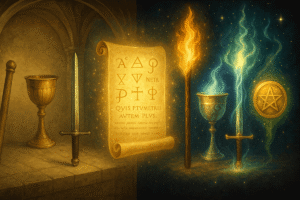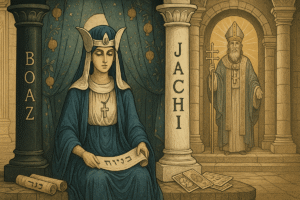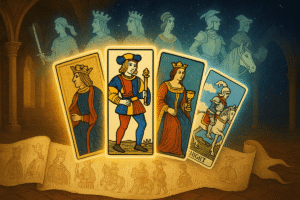Table of Contents
When I first started exploring different tarot decks, I noticed something puzzling. The Justice card was numbered 11 in some decks and 8 in others. The same thing happened with Strength. At first, I thought it was just printing errors or different artistic interpretations. Perhaps many people have had this same moment of confusion when comparing their Rider-Waite-Smith deck to an older Marseille deck.
This numerical mystery actually reveals one of the most significant changes in tarot history. The story behind this swap offers fascinating insights into how esoteric traditions evolve and adapt over time.
The Historical Context of Card Numbering
Traditional tarot decks, particularly those following the Marseille pattern, maintained a specific numerical order for centuries. In these classic systems, Justice held the eighth position while Strength occupied the eleventh spot. This arrangement wasn’t arbitrary. It reflected centuries of European mystical thinking and symbolic associations that had been carefully preserved through generations of card makers and readers.
The Marseille tradition, which emerged in the 17th and 18th centuries, represented a crystallization of earlier tarot forms. These decks carried forward numerical sequences that likely had roots stretching back to the Renaissance, when tarot first appeared in Italian courts. The consistency of this numbering across different regions and time periods suggests it held particular significance for practitioners of the time.
When you examine historical decks, this traditional ordering feels quite deliberate. Justice at 8 creates certain numerical relationships with other cards, while Strength at 11 sits in a different symbolic space entirely. The question becomes: what prompted such a dramatic departure from this established tradition?
Arthur Edward Waite’s Revolutionary Decision
Arthur Edward Waite, the creator of what we now call the Rider-Waite-Smith deck, made the bold choice to reverse these positions in 1909. In his influential deck, Justice became card 11 and Strength took the 8th position. This wasn’t a casual decision or an oversight. Waite was deeply versed in esoteric traditions and understood the weight of such a change.
Waite belonged to the Hermetic Order of the Golden Dawn, a magical society that had developed sophisticated correspondences between tarot cards, astrology, Kabbalah, and other mystical systems. The Golden Dawn’s approach to tarot was highly systematic, perhaps more so than earlier traditions. Every symbol, color, and number carried specific meaning within their elaborate framework.
The decision to swap Justice and Strength likely emerged from this systematic approach. The Golden Dawn sought to create perfect correspondences between different symbolic systems. Sometimes this meant departing from historical precedent to achieve what they perceived as greater magical accuracy or effectiveness.
I think it’s worth considering how radical this change must have seemed to tarot readers of the early 20th century. Imagine if someone today suddenly announced that The Fool should be numbered 5 instead of 0. That’s roughly the level of disruption Waite introduced to the tarot world.
Astrological Connections and the Swap
The most commonly cited reason for Waite’s swap involves astrological correspondences. In the Golden Dawn system, each tarot card connects to specific astrological energies. These connections weren’t random but followed particular patterns based on the Hebrew alphabet, planetary associations, and zodiacal relationships.
Strength traditionally connects to the astrological sign Leo, a fire sign ruled by the Sun. Leo energy embodies courage, creativity, and personal power. The lion imagery in most Strength cards directly references this leonine connection. In astrological sequences, Leo appears as the fifth sign of the zodiac, but when considering only the zodiacal trumps in tarot, different numerical relationships emerge.
Justice, on the other hand, corresponds to Libra, the sign of balance, fairness, and cosmic order. Libra seeks equilibrium and weighs all sides of any situation. The scales imagery in Justice cards clearly reflects these Libran qualities. In the zodiacal sequence, Libra follows Leo, but again, the specific numerical relationships within tarot’s structure create particular considerations.
Perhaps the swap emerged from Waite’s desire to align these astrological correspondences with what he perceived as a more natural numerical progression. The Golden Dawn system included complex relationships between the Hebrew alphabet, the Tree of Life, and various other symbolic frameworks. Achieving perfect alignment across all these systems might have required adjusting the traditional tarot sequence.
However, I should mention that not all modern astrologers and tarot readers agree on these correspondences. Some contemporary practitioners maintain different relationships between cards and astrological energies. This diversity of opinion suggests that the “correct” correspondences might be more flexible than any single tradition claims.
The Hermetic Influence on Modern Tarot
The Golden Dawn’s influence on modern tarot extends far beyond just this numerical swap. Their systematic approach to correspondences shaped how many people understand and work with tarot cards today. Before the Golden Dawn, tarot traditions varied significantly between regions and practitioners. The Order’s documentation and teaching materials created a more standardized framework.
This systematization had both benefits and drawbacks. On one hand, it provided clear guidelines for understanding card meanings and relationships. Students could learn consistent interpretations and build upon established foundations. On the other hand, it potentially reduced the intuitive and folk wisdom elements that had characterized earlier tarot traditions.
The Justice and Strength swap exemplifies this tension between systematic perfection and historical continuity. Waite prioritized what he saw as correct correspondences over traditional numbering. This choice reflected broader changes happening in Western esotericism during the early 20th century, as practitioners sought to create more scientific and systematic approaches to mystical studies.
Modern tarot readers inherit this complexity. Some prefer the historical Marseille numbering, feeling it connects them to older traditions. Others embrace Waite’s system, appreciating its astrological alignments. Still others create their own correspondence systems based on personal experience and intuition.
Symbolic Implications of the Swap
Beyond astrological considerations, the swap carries interesting symbolic implications for how we might understand these archetypes. When Justice sits at position 8, it occupies a space traditionally associated with material manifestation and earthly power. Eight often represents achievement, success, and the concrete results of sustained effort.
Placing Justice here suggests that true fairness and balance emerge from practical experience and worldly engagement. This Justice isn’t abstract moral philosophy but rather the hard-won wisdom that comes from navigating real-world challenges and conflicts.
Strength at position 11, however, occupies a more transcendent space. Eleven often represents intuition, spiritual insight, and the ability to perceive beyond ordinary reality. This positioning suggests that true strength isn’t physical force but rather the inner fortitude that comes from spiritual development and self-understanding.
Waite’s arrangement creates a different narrative flow through the Major Arcana. Instead of encountering Justice before Strength, we meet Strength first, learning about inner mastery and self-control. Only later do we encounter Justice, perhaps suggesting that fair judgment requires the wisdom and restraint that Strength teaches.
I find myself wondering whether this reordering reflects changing social values of the early 20th century. Perhaps Waite sensed that his era needed to emphasize personal strength and self-discipline before addressing questions of social justice and fairness.
Contemporary Perspectives on the Swap
Today’s tarot community remains divided on this numerical question. Some publishers continue to follow Waite’s precedent, while others return to historical Marseille numbering. A few contemporary deck creators have experimented with entirely different arrangements, questioning whether any fixed numerical sequence is necessary.
This ongoing debate reveals something important about how esoteric traditions evolve. Unlike scientific fields where new discoveries can definitively replace old theories, mystical traditions often maintain multiple valid approaches simultaneously. The “correct” numbering might depend more on what resonates with individual practitioners than on any objective historical or theoretical standard.
Perhaps this flexibility is actually one of tarot’s greatest strengths. Rather than being locked into rigid dogma, the tradition allows for adaptation and personal interpretation. The Justice and Strength swap becomes not a problem to solve but an opportunity to reflect on what these archetypes mean in our own lives and practice.
The question isn’t necessarily which numbering is “right” but rather which arrangement serves your understanding and growth. Some people find that working with Justice as 8 and Strength as 11 creates meaningful insights and connections. Others prefer the reverse. Still others work with both systems, drawing different lessons from each approach.
Reflection and Personal Practice
As you explore different tarot decks and traditions, you might consider experimenting with both numbering systems. Try working with a Marseille-style deck where Justice is 8 and Strength is 11. Then spend time with a Rider-Waite-Smith deck or its variants where the positions reverse. Notice what different insights emerge from each arrangement.
You might ask yourself: How does encountering Justice before Strength change the story you tell about personal development? What happens when you reverse that order? Which sequence feels more natural or meaningful for your current life circumstances?
These aren’t questions with predetermined answers. Your responses will depend on your personal experiences, cultural background, and current challenges. The great tarot card swap ultimately invites us to think more deeply about how symbolic systems serve our understanding and growth.
The numerical disagreement between traditions reminds us that tarot’s power lies not in rigid adherence to any single system but in its ability to spark reflection and insight. Whether Justice comes before Strength or after, both archetypes offer valuable wisdom for navigating life’s complexities.
Perhaps Waite’s legacy lies not in establishing the “correct” order but in demonstrating that traditions can evolve and adapt while still maintaining their essential wisdom and power.
Frequently Asked Questions
Which tarot decks use Justice as 8 and Strength as 11?
Traditional decks like the Tarot de Marseille, Visconti-Sforza, Thoth (by Aleister Crowley), and most Lo Scarabeo decks maintain the historical numbering with Justice as card 8 and Strength as card 11. This was the standard arrangement for centuries before the Golden Dawn’s influence, and many contemporary deck creators still prefer this traditional ordering, viewing it as a connection to tarot’s historical roots.
Does the card numbering affect tarot readings?
For most readers, the numbering doesn’t significantly impact individual card interpretations during readings, since the core meaning of each card remains consistent regardless of its position. However, the numbering can matter when calculating personality cards, soul cards, or year cards based on birth dates, where the number 8 or 11 could point to either Justice or Strength depending on which system your deck follows. Some readers simply acknowledge both possibilities when these calculations arise.
Why did Crowley keep the old numbering in the Thoth deck?
While Crowley agreed with the Golden Dawn’s astrological correspondences (linking Strength to Leo and Justice to Libra), he chose to return to the traditional Marseille numbering system, possibly as a deliberate departure from Waite’s approach. The Thoth deck maintains Justice (called Adjustment) as 8 and Strength (called Lust) as 11, yet internally follows the same astrological and Kabbalistic associations as the Golden Dawn system, demonstrating that correspondence systems and numerical ordering can exist somewhat independently.







